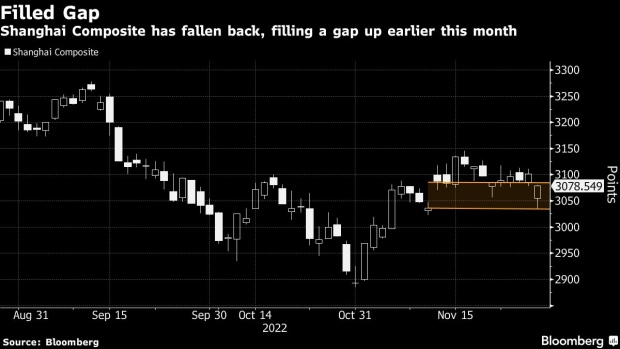Nov 28, 2022
Investors Crave More Clarity Before Placing More Bets on China's Exit From Covid Zero
, Bloomberg News

(Bloomberg) -- China’s complicated and disorderly exit from Covid Zero has left traders waiting for new triggers to provide clarity on the outlook before they deploy more capital.
While equities remain cheap, onshore portfolio managers are unsure which sectors they should allocate funds to or when to increase positions. Some say that more explicit communication of Covid measures and economic policy, and perhaps a further drop in markets, might be needed to end the confusion.
While China recently rolled out 20 optimization measures aimed at easing some restrictions, many communities in recent weeks imposed their own “targeted lockdowns” as cases flared. Anger over these piecemeal local curbs, many which clash with the government’s guidelines, helped fuel protests in Chinese cities over the weekend, triggering a 1.1% drop in the CSI 300 on Monday. The index regained ground early Tuesday, trading up as much as 1.3%.
“The chief concern is that the Covid policy and execution of the optimization measures remain foggy, with some whiplashing on the ground and leading to a lot of noise and disorder,” said Yu Aibin, a fund manager at Shenzhen Jointfull Capital Management Co. “Time will be the key solution out of the dilemma as it takes time to figure out how to strike a balance and form a consensus on Covid and growth.”
Some investors assess that it’s too early to jump back in before consensus forms on the likely path of reopening and until Beijing provides more detailed rules. While awaiting clarity, a pair of widely watched meetings in December could provide a catalyst for further gains.
“The Central Economic Work Conference and the Politburo could be key events to help the market build consensus that it lacks at the moment, and could offer direction on industrial policies and a trigger for a new round of gains,” Sinolink Securities analyst Ai Xiongfeng wrote in a note.
Shenzhen Jointfull’s Yu said he will be studying readouts from the meetings for clues about the nation’s priorities next year.
“After the five-year blueprint on economic development, revealed at the party congress, I am keen to see how the authorities iterate finding a balance between Covid and growth targets, what degree of support can we expect for property next and what the tone will be in preventing systemic risk going forward,” he said.
While some investors see scope for bargain hunting in China’s markets, short-term chart observers may wait for a further move lower, which would make prices more tempting.
The Shanghai Composite on Monday filled in a gap created by its recent rally following a move lower -- a positive sign among chartists. Stocks are also on the brink of testing their decade-long “fate line”, a trend line that has provided long-term support almost without fail.
Other investors say that with such little clarity it is difficult to pinpoint which measures may help bolster confidence and increase risk appetite.
“I’m not expecting results overnight as we try to pivot, there may be incremental changes here and there, but it impossible to anticipate what the inflection point will be, we will only know in hindsight,” said Lin Menghan, fund manager at Shanghai Xiejie Asset Management Co. “The best strategy we think is to wait with cash on hand, and bide out time as things slowly unfold.”
©2022 Bloomberg L.P.





